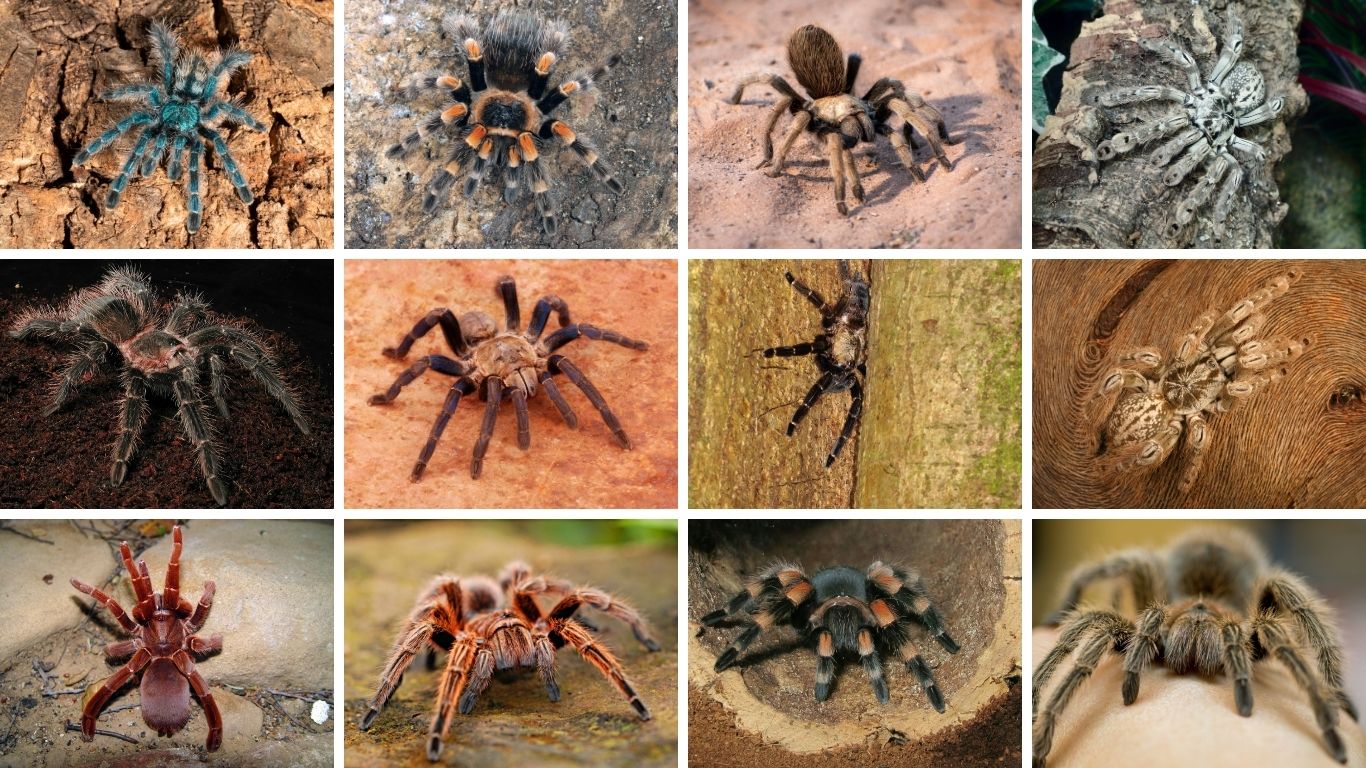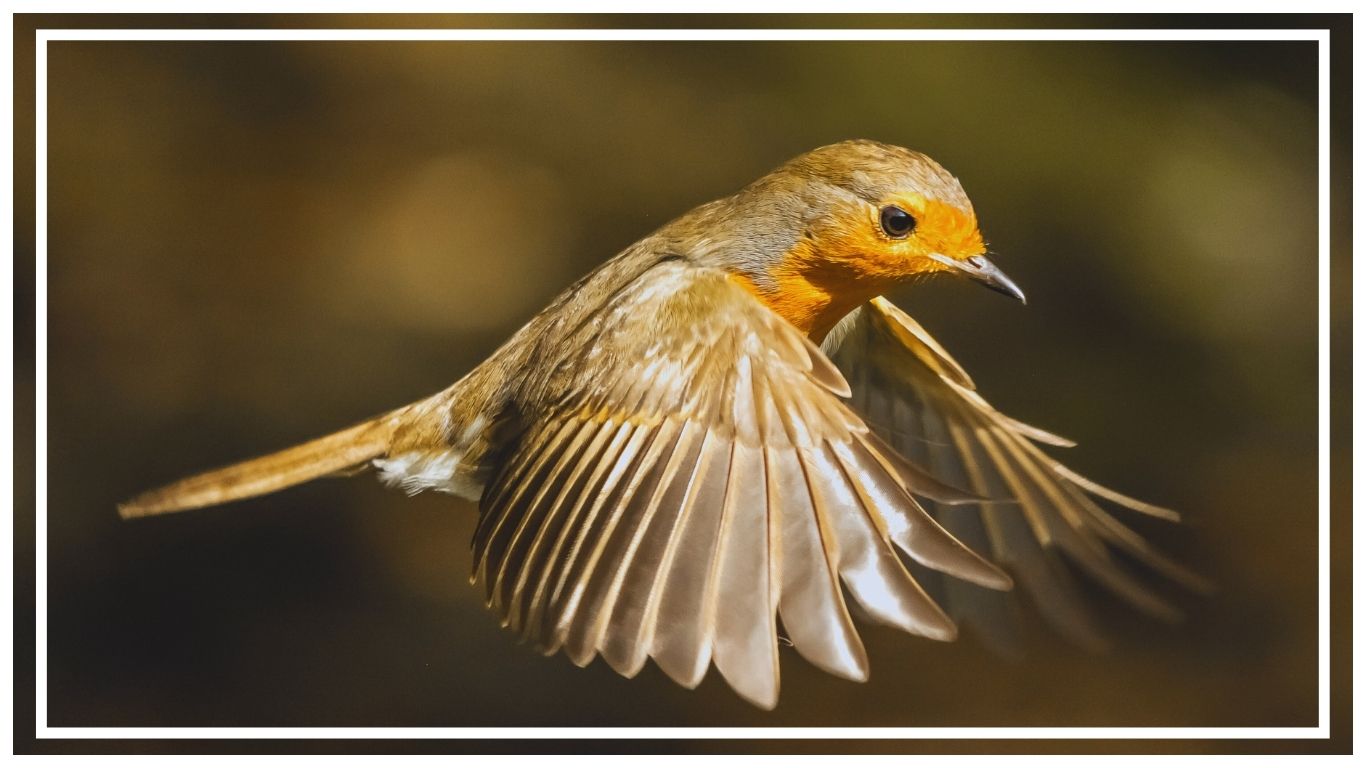Eagles are among the most powerful and admired birds of prey, known for their sharp vision, strong talons, and majestic flight. Found across every continent except Antarctica, each eagle species has unique features and hunting styles. In this guide, you’ll discover 25 fascinating types of eagles, from the iconic Bald Eagle to the rare Philippine Eagle.
1. Golden Eagle
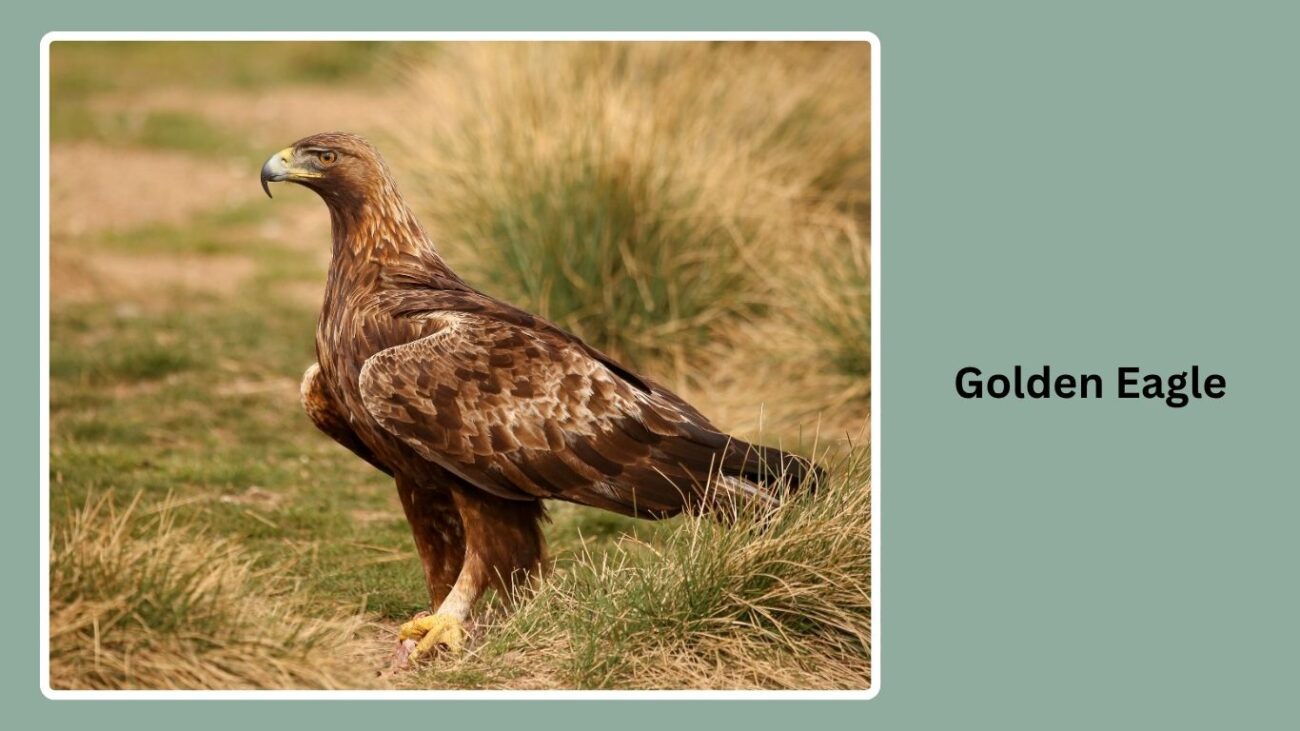
The Golden Eagle (Aquila chrysaetos) is one of the most powerful and widespread eagles in the Northern Hemisphere. Revered in many cultures for its strength and grace, this majestic bird is known for its dark brown feathers, golden sheen on the back of its head and neck, and fierce hunting abilities. It thrives in open and semi-open landscapes like mountains, cliffs, and grasslands.
Identification
- Dark brown body with golden feathers on the neck
- Broad wings and long tail
- Beak is dark at the tip, fading to yellow at the base
- Legs feathered down to the toes
- Wingspan: 6 to 7.5 feet
- Juveniles may have white patches on the wings and tail
Color Pattern
Golden Eagles have a rich, dark brown plumage with a golden-bronze hue on the back of the head and neck. The golden color is more pronounced in adults, while younger birds show contrasting white patches on their wings and tail.
Habitat
They prefer wide-open spaces such as mountains, plateaus, grasslands, and deserts. They are commonly found in North America, Europe, Asia, and parts of North Africa, often nesting on cliffs or tall trees in remote areas.
Hunting and Diet
Golden Eagles are powerful hunters that rely on speed, stealth, and strength to take down prey. They mainly hunt small to medium-sized mammals like rabbits, hares, and ground squirrels but can also target birds and reptiles. Their keen eyesight allows them to detect movement from afar, and once locked in, they dive swiftly to capture their target. They may also scavenge on carrion when live prey is limited, showing flexibility in feeding habits.
3. Harpy Eagle
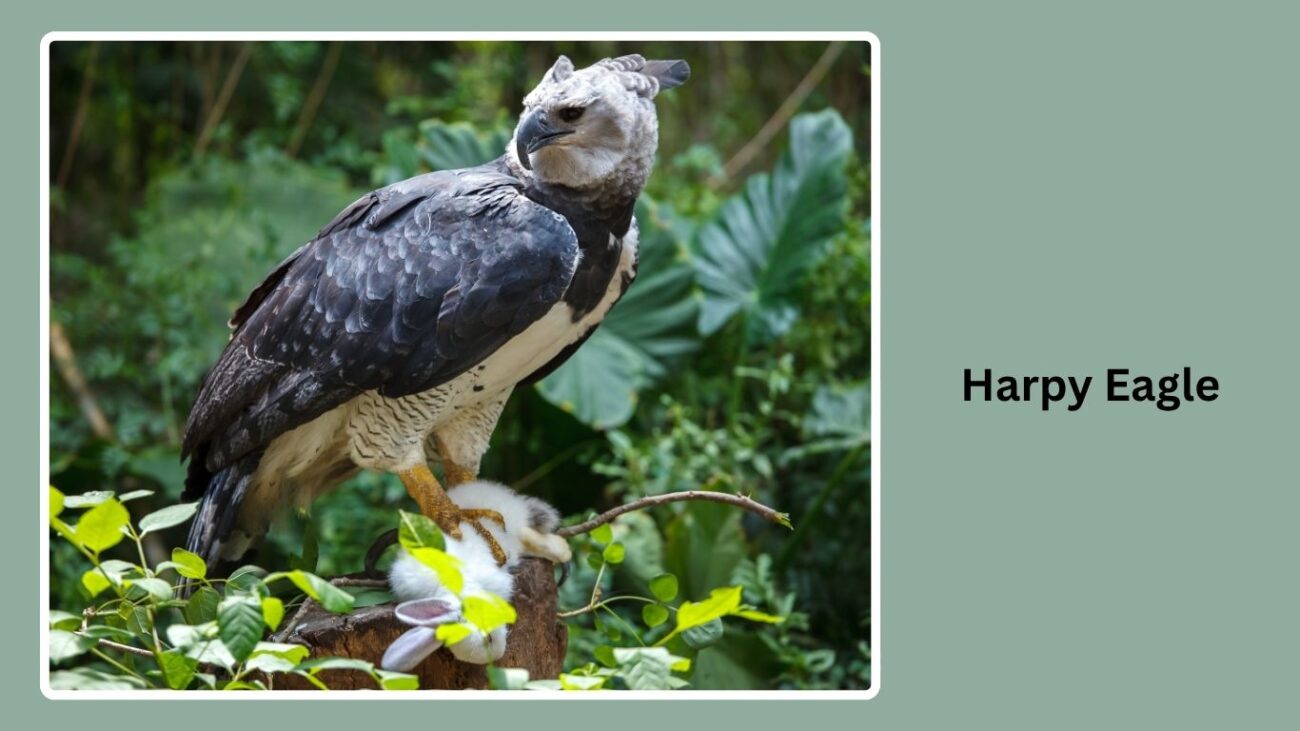
The Harpy Eagle (Harpia harpyja) is one of the largest and most powerful eagles in the world, native to the tropical rainforests of Central and South America. Known for its striking crown of feathers, piercing eyes, and massive size, this eagle is a top predator in its ecosystem and often lives in tall, emergent rainforest trees.
Identification
- Slate-gray upper body with a white belly
- Distinct double crest of feathers on the head
- Facial disk resembles an owl’s for sound direction
- Legs are extremely thick with large talons
- Wingspan: about 6.5 to 7 feet
- Females are significantly larger than males
Color Pattern
Harpy Eagles have a dramatic look—blackish-gray back, white underside, and a black band across the chest. Their feathered legs and dark gray face framed by a spiky crown give them a fearsome and unique appearance.
Habitat
They live in lowland tropical rainforests, especially in tall trees suitable for nesting. They are mainly found in Brazil, Panama, and other parts of Central and South America, often in undisturbed forest canopies.
Hunting and Diet
Harpy Eagles are expert ambush hunters. They often wait silently and strike with powerful talons to capture sloths, monkeys, and other arboreal mammals. Their strong legs and crushing grip allow them to subdue large prey, sometimes heavier than themselves. They hunt from high perches and depend on dense forest cover for stealth.
4. Philippine Eagle

The Philippine Eagle (Pithecophaga jefferyi), also known as the monkey-eating eagle, is a critically endangered bird found only in the Philippines. It’s one of the tallest and rarest eagles in the world, known for its shaggy crest and fierce gaze. It is the national bird of the Philippines and a symbol of wildlife conservation.
Identification
- Creamy white underside and legs
- Brown back and wings with black-tipped crest feathers
- Strong blue-gray hooked beak
- Long tail and broad wings
- Can stand over 3 feet tall with a wingspan of 6 to 7 feet
Color Pattern
Philippine Eagles have a bold, contrasty pattern with light underparts and darker upper parts. Their shaggy head feathers form a prominent crest, giving them a lion-like appearance.
Habitat
They inhabit the rainforests of several Philippine islands, including Luzon, Mindanao, Leyte, and Samar. They prefer dense forests with tall trees, where they nest and hunt in solitude.
Hunting and Diet
Despite their nickname, Philippine Eagles don’t just eat monkeys. Their diet includes flying lemurs, snakes, birds, and large rodents. They hunt using high perches to launch powerful attacks. Their isolation and reliance on large hunting territories contribute to their endangered status, as deforestation threatens their survival.
7. African Fish Eagle
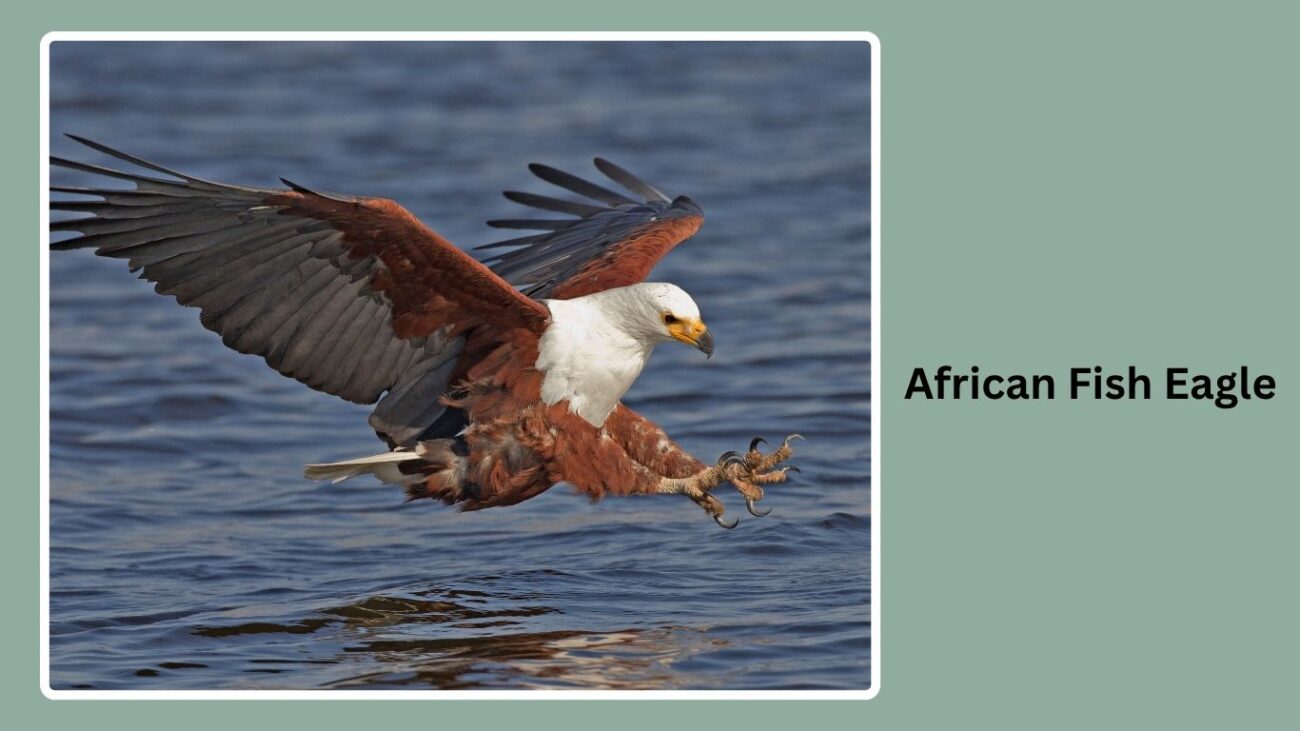
The African Fish Eagle (Haliaeetus vocifer) is one of the most iconic birds in Africa, instantly recognized by its loud, echoing call that often symbolizes the wild African landscape. Found near rivers, lakes, and wetlands, it is closely related to the Bald Eagle and White-tailed Eagle and shares their love for fish.
Identification
- White head, chest, and tail
- Chestnut-brown body and wings
- Black back and wing edges
- Yellow face with a hooked black beak
- Wingspan: 6 to 7.5 feet
Color Pattern
The African Fish Eagle features a striking contrast between its white head and chestnut-brown body, with black wings. The beak is yellow with a black tip, and the eyes are dark brown.
Habitat
These eagles live across sub-Saharan Africa, especially near freshwater lakes, rivers, and swamps. They prefer areas with large, open water sources and tall trees for nesting and perching.
Hunting and Diet
As the name suggests, fish make up the majority of their diet. They hunt by flying over water, then swooping down to grab fish near the surface with their sharp talons. They also eat waterbirds, turtles, and carrion when fish are not available. Their loud, echoing call is often heard in the early morning and evening.
8. Crowned Eagle
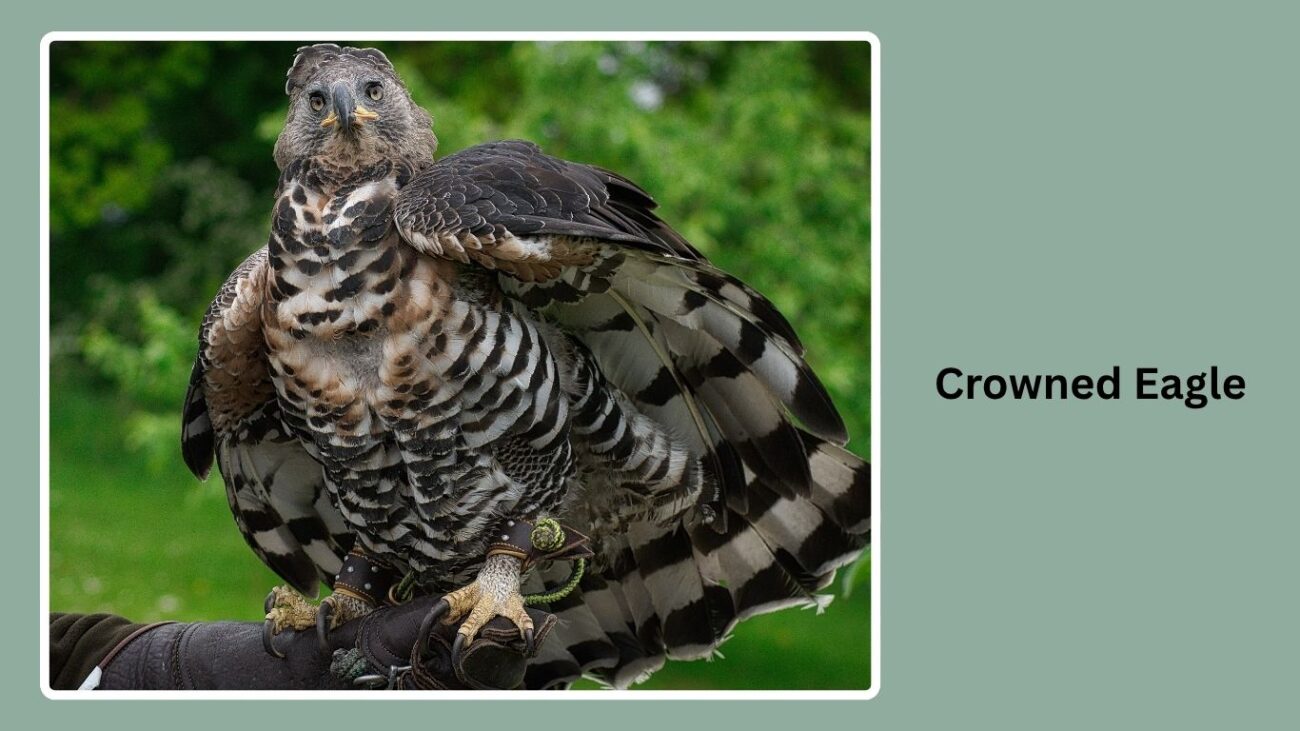
The Crowned Eagle (Stephanoaetus coronatus) is one of the most powerful forest eagles in Africa, known for its muscular build and ability to take down large prey. It lives in dense woodlands and rainforests and is often heard before seen, thanks to its high-pitched calls and territorial displays.
Identification
- Dark brown upperparts with a cream-colored underside
- Bold black bars on the chest and legs
- Striking feathered crest on the head
- Powerful legs with thick, scaled talons
- Wingspan: 5 to 6 feet
Color Pattern
Crowned Eagles have a cream to whitish chest heavily barred with black, dark brown wings and back, and a distinctive crest. Their powerful legs are covered in thick feathers.
Habitat
They inhabit dense tropical forests, wooded hills, and riverine areas throughout sub-Saharan Africa. They prefer areas with plenty of cover for ambush hunting and tall trees for nesting.
Hunting and Diet
Crowned Eagles are known for taking large mammals like monkeys, small antelope, and hyraxes. They hunt by silently watching from a perch, then launching a swift and powerful strike. Their talons are strong enough to kill prey nearly their own size. Their hunting style and strength make them one of Africa’s top avian predators.
9. Martial Eagle
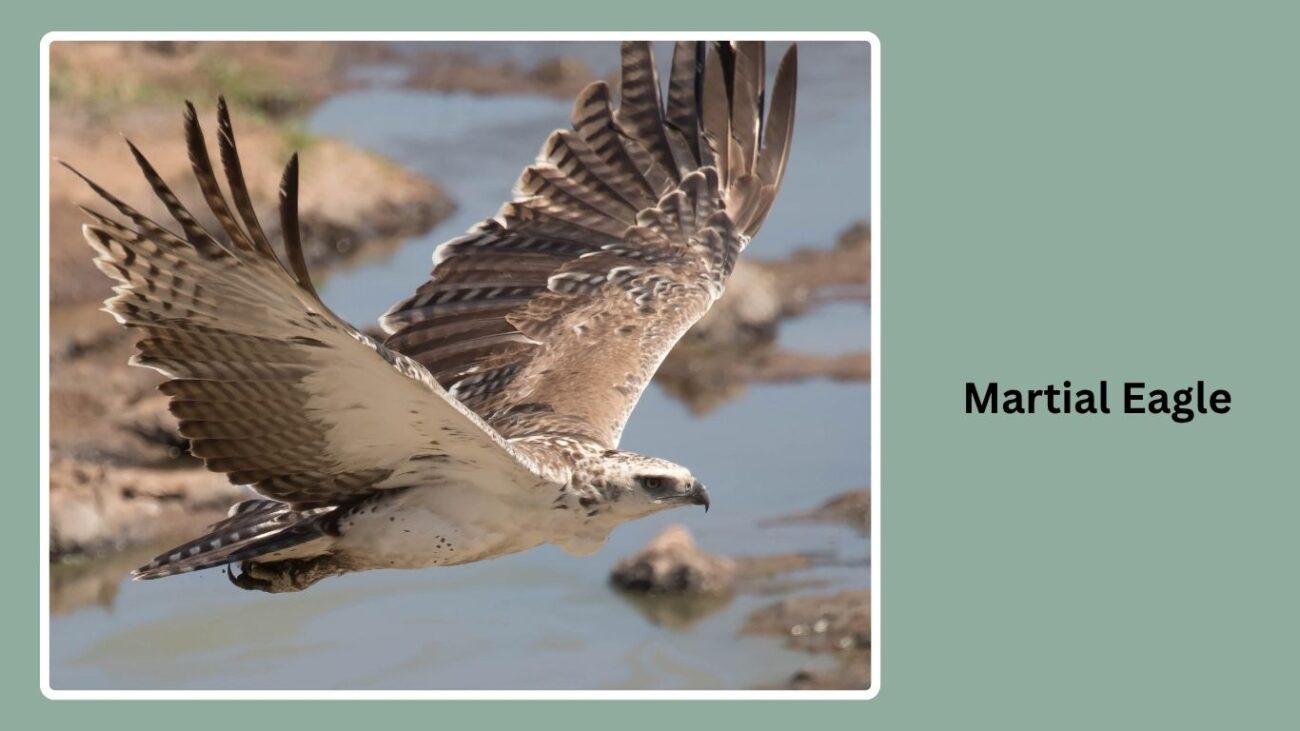
The Martial Eagle (Polemaetus bellicosus) is the largest eagle in Africa and one of the most fearsome avian predators on the continent. Known for its sheer size, sharp vision, and powerful talons, it can take down large prey with ease. This eagle is often seen soaring high in open skies across savannas and semi-arid regions.
Identification
- Dark brown head and upperparts
- White belly covered with dark brown spots
- Bright yellow eyes
- Long wings and short tail
- Wingspan: up to 7.5 feet
Color Pattern
Adults show a rich brown upper body with a contrasting white belly spotted with dark markings. The underwings are pale with a barred pattern, and the eyes are a piercing yellow.
Habitat
Martial Eagles inhabit open woodlands, savannas, and thornbush areas across sub-Saharan Africa. They often perch in tall trees or soar at high altitudes during hunts.
Hunting and Diet
These eagles are apex predators, hunting birds like guineafowl, mammals such as hares, monkeys, and even young antelope. They hunt from high above, diving with incredible force to capture prey. Their diet is diverse, and they can also feed on reptiles and carrion when necessary.
10. Steppe Eagle

The Steppe Eagle (Aquila nipalensis) is a large migratory raptor that breeds in the steppes and semi-deserts of Central Asia and winters in Africa and the Indian subcontinent. It’s known for its endurance, long-distance migration, and strong build.
Identification
- Uniform dark brown plumage
- Pale throat and nape in some individuals
- Yellow cere and feet
- Strong, hooked beak
- Wingspan: 6 to 7 feet
Color Pattern
Mostly dark brown throughout, with slight variations depending on age and individual. Some may show paler patches on the nape or flight feathers, and their yellow cere and feet contrast sharply with the plumage.
Habitat
They breed in dry, open areas like steppes, deserts, and semi-arid plains. In winter, they are found in grasslands, farmlands, and even near human settlements in Africa, India, and the Middle East.
Hunting and Diet
Steppe Eagles feed on small to medium-sized mammals like ground squirrels, hares, and reptiles. They also eat carrion, particularly during migration. Their sharp eyesight helps them spot prey from great distances, and they often perch on power poles or rocks to scan for movement.
11. Eastern Imperial Eagle

The Eastern Imperial Eagle (Aquila heliaca) is a majestic and powerful bird of prey native to southeastern Europe, Central Asia, and parts of the Middle East. It’s a large, dark eagle with bold features and a strong presence, often seen soaring over open plains and woodlands.
Identification
- Dark brown body with golden-buff nape
- Pale shoulder patches visible in flight
- Yellow feet and cere
- Strong, slightly arched beak
- Wingspan: around 6.5 to 7.5 feet
Color Pattern
Adults are mostly dark brown with golden tones on the back of the neck and shoulders. Juveniles are paler with sandy-brown plumage and dark streaks. The underwings show contrast with lighter flight feathers and dark coverts.
Habitat
They breed in open woodlands, grasslands, and semi-deserts, nesting in tall trees or cliffs. In winter, they migrate to warmer regions including the Middle East, India, and North Africa.
Hunting and Diet
Eastern Imperial Eagles hunt a variety of prey including ground squirrels, birds, reptiles, and small mammals. They also scavenge, especially during migration, feeding on roadkill or livestock carcasses. They rely on both soaring flight and surprise attacks when hunting.
12. Spanish Imperial Eagle
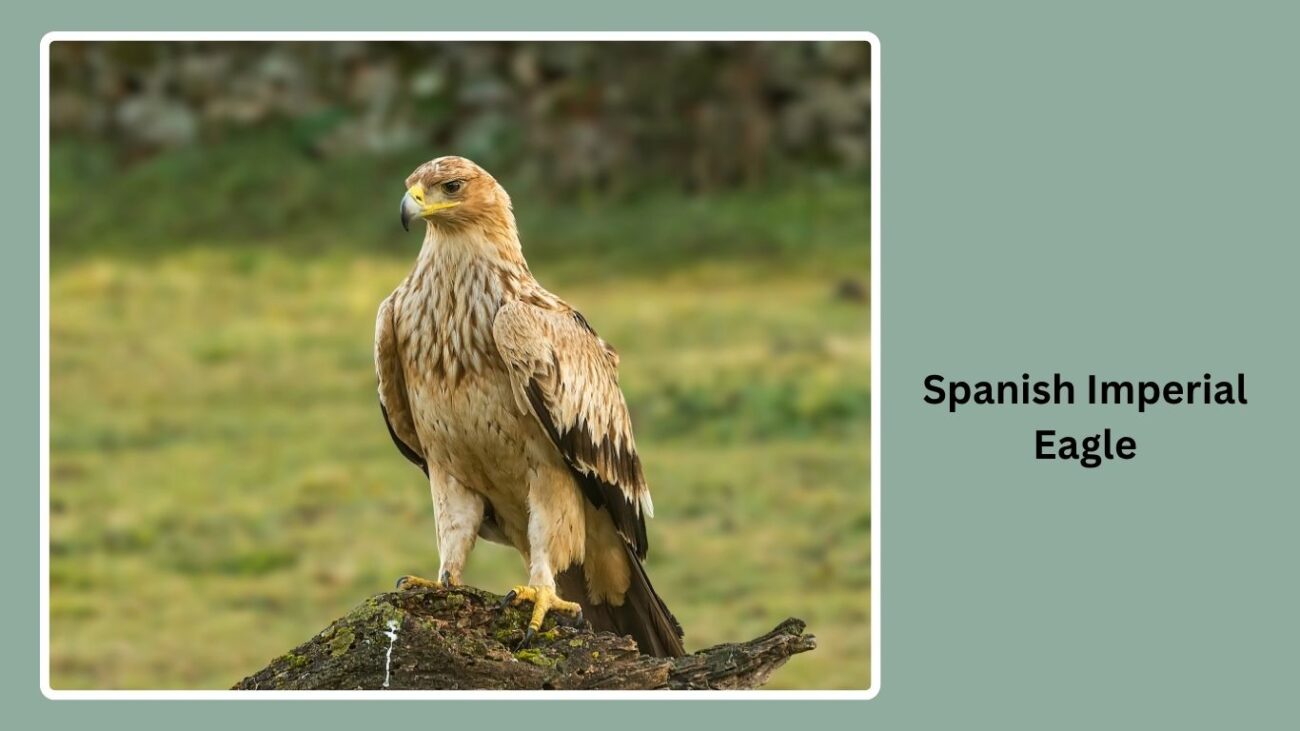
The Spanish Imperial Eagle (Aquila adalberti) is a rare and endangered raptor found mainly in central and southwestern Spain. Closely related to the Eastern Imperial Eagle, it is slightly smaller but shares a similar look and behavior. Conservation efforts have helped boost its population in recent years.
Identification
- Dark brown body with white shoulders
- Pale crown and neck
- Yellow beak base and feet
- Short tail and broad wings
- Wingspan: 6 to 7 feet
Color Pattern
This eagle has a rich dark brown body with prominent white patches on the shoulders. The head and neck are paler, and the eyes are dark. Juveniles are lighter brown overall with buff tones and dark streaking.
Habitat
Found in Mediterranean woodlands, dehesas (open oak forests), and river valleys in Spain and Portugal. They require tall trees for nesting and open spaces for hunting.
Hunting and Diet
Spanish Imperial Eagles primarily feed on rabbits, which make up most of their diet. They also prey on birds, reptiles, and carrion. Their survival is closely tied to rabbit populations, and habitat protection is key to their conservation. They hunt by gliding low over the ground or from elevated perches.
13. Wedge-tailed Eagle

The Wedge-tailed Eagle (Aquila audax) is Australia’s largest bird of prey and one of the biggest eagles in the world. Named for its distinctive wedge-shaped tail, this powerful raptor is known for its soaring flight and ability to cover vast open landscapes, from deserts to forests.
Identification
- Long, wedge-shaped tail
- Dark brown to black plumage
- Pale brown nape (golden tone in adults)
- Broad wings with fingered tips
- Wingspan: up to 9 feet
Color Pattern
Adults are dark brown to black with a slight golden tint on the back of the head and neck. Juveniles are lighter brown and darken with age. The wedge-shaped tail is a key identifying feature in flight.
Habitat
They inhabit nearly all of Australia, including Tasmania, and prefer open woodlands, plains, and arid regions. They build massive nests in tall trees or cliff ledges.
Hunting and Diet
Wedge-tailed Eagles hunt rabbits, hares, wallabies, and reptiles. They are also frequent scavengers, feeding on roadkill and livestock carcasses. These eagles are strong fliers and often soar for hours searching for prey or carrion. They may hunt in pairs or family groups.
14. Black-chested Buzzard-Eagle
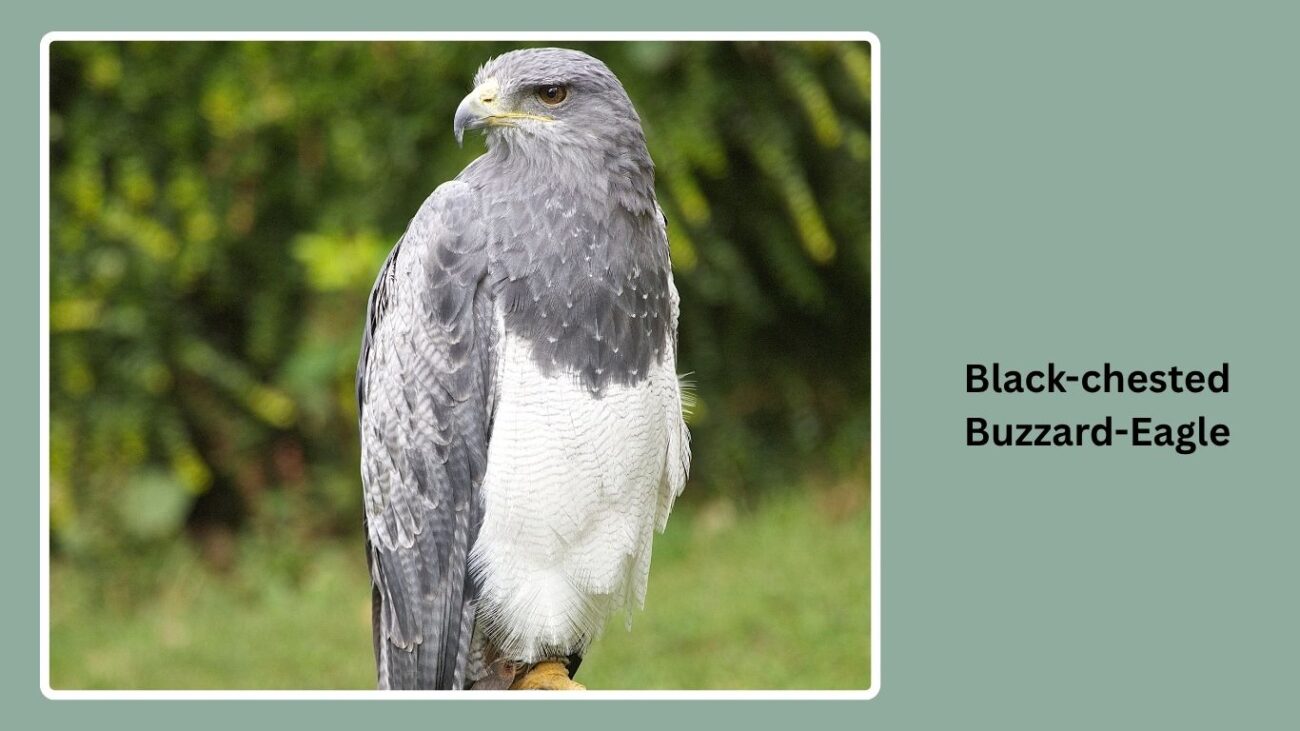
The Black-chested Buzzard-Eagle (Geranoaetus melanoleucus) is a large and powerful raptor native to South America. Despite its name, it’s more eagle than buzzard in terms of behavior and strength. Known for its broad wings and black chest, it often soars over mountainous terrain and open fields.
Identification
- Slate-gray upper body
- White belly with a solid black chest band
- Short, fan-shaped tail
- Thick, hooked beak
- Wingspan: 5.5 to 6.5 feet
Color Pattern
This eagle has a striking two-toned appearance: dark gray to black above, white below, and a broad black band across the chest. Juveniles are browner and mottled, lacking the solid chest band.
Habitat
They live in open mountainous regions, cliffs, and high-altitude grasslands across Argentina, Chile, Peru, and other Andean areas. They often nest on rocky ledges.
Hunting and Diet
Black-chested Buzzard-Eagles prey on small mammals, reptiles, and birds. They use soaring flight to patrol hunting grounds and are known for sudden, powerful dives to catch prey. They may also eat carrion, especially in higher elevations where food is scarce.
15. Indian Spotted Eagle

The Indian Spotted Eagle (Clanga hastata) is a medium-to-large eagle found primarily in the Indian subcontinent. Unlike its close relatives, this species prefers wetter and more wooded habitats, and it’s known for its rounded wings and relatively short tail.
Identification
- Uniform brown body with faint white spotting on wings
- Pale eyes and yellow cere
- Rounded wings and short tail
- Slight crest on the head
- Wingspan: about 5.5 to 6.5 feet
Color Pattern
This eagle is mostly dark brown with slightly lighter feathers on the head and neck. Pale spotting may be seen on the upper wings in good light. Its eyes are pale yellow to whitish, giving it a piercing look.
Habitat
Found in India, Nepal, Bangladesh, and parts of Myanmar, the Indian Spotted Eagle prefers wetlands, agricultural fields, forest edges, and grasslands. It often nests in tall trees near water bodies or rural areas.
Hunting and Diet
It hunts small mammals, reptiles, frogs, birds, and insects. The Indian Spotted Eagle uses both soaring flight and perching techniques to ambush prey. It may also feed on carrion, especially near villages or roads.
16. Greater Spotted Eagle
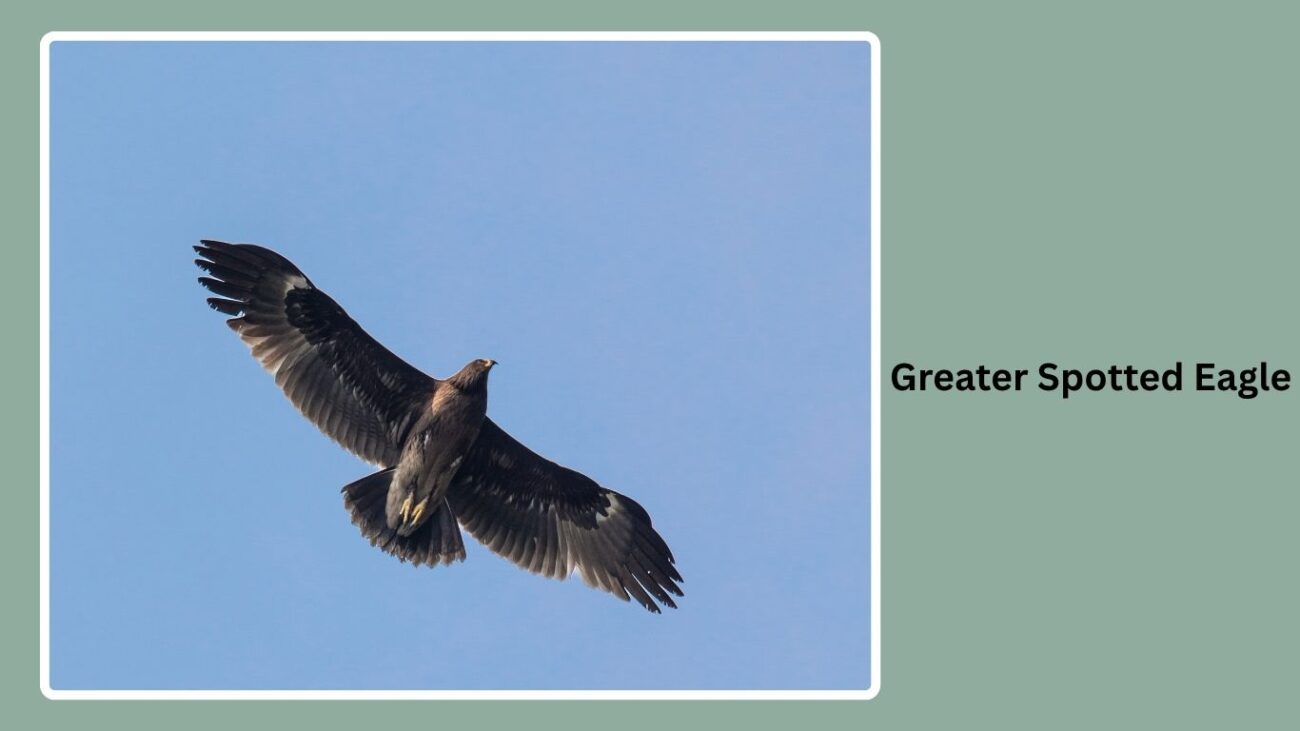
The Greater Spotted Eagle (Clanga clanga) is a large migratory eagle that breeds in eastern Europe and northern Asia and winters in the Middle East, India, and Southeast Asia. It’s known for its slightly bulky build, somber plumage, and preference for marshy habitats.
Identification
- Dark brown plumage with faint lighter spots
- Feathers cover legs down to the feet
- Broad wings with slight bulge at the base
- Yellow legs and feet
- Wingspan: about 6 to 6.5 feet
Color Pattern
Mostly dark brown overall with some lighter spotting on the upper wings and back, especially in younger birds. Adults appear darker and more uniform, while juveniles may show paler streaks and wing markings.
Habitat
They prefer wetland areas like marshes, floodplains, and riverbanks. Nesting is done in tall trees near water, and wintering areas include rice fields, lakes, and dry forests.
Hunting and Diet
The Greater Spotted Eagle feeds on small mammals, birds, frogs, and reptiles. It hunts from high perches or during slow flights over open areas. In winter, it may scavenge more frequently, taking advantage of human-modified landscapes.
17. Booted Eagle
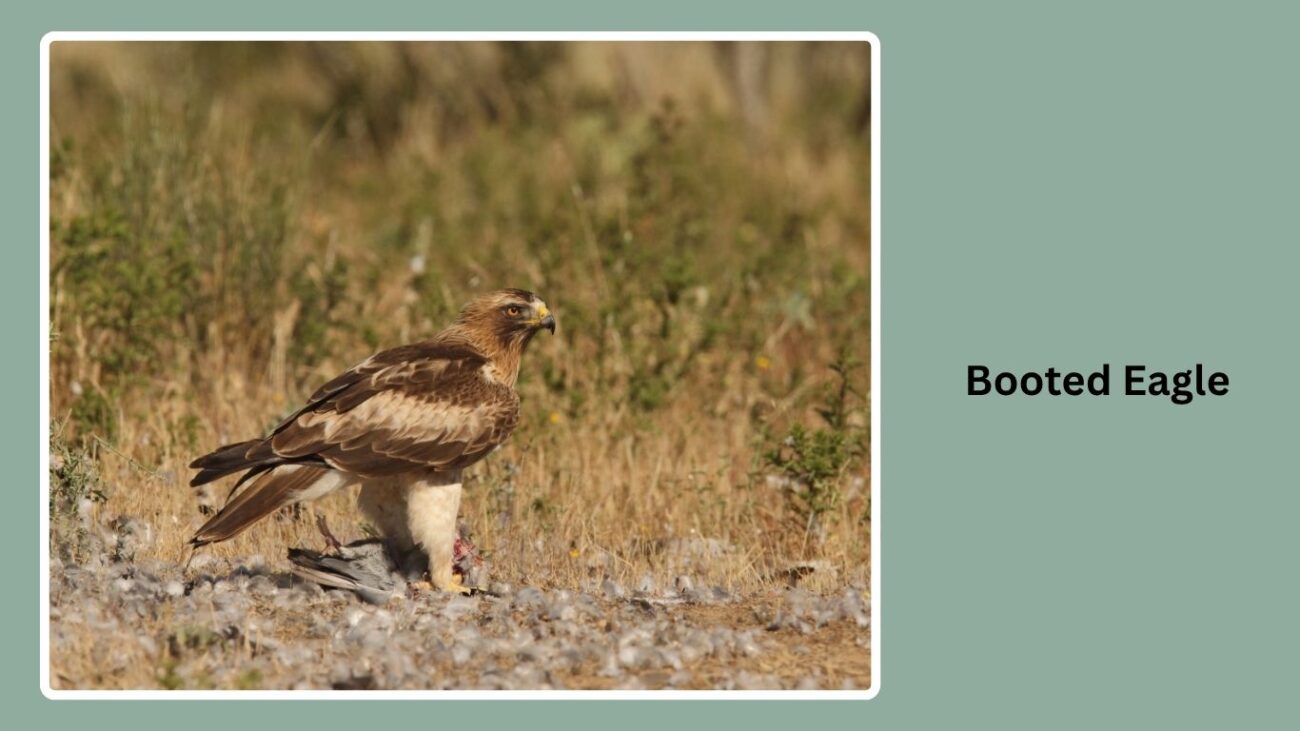
The Booted Eagle (Hieraaetus pennatus) is a small, agile eagle found across Europe, Asia, and parts of Africa. Despite its size, it’s a skilled hunter and highly adaptable, often nesting in forested areas and hunting in open habitats. It gets its name from the feathering that extends down its legs, resembling boots.
Identification
- Comes in two color morphs: light and dark
- Light morph: pale underparts with dark flight feathers
- Dark morph: uniformly dark brown with slightly paler underwings
- Yellow legs and feet
- Wingspan: 4.5 to 5.5 feet
Color Pattern
The light morph features creamy underparts with a contrasting dark trailing edge on the wings, while the dark morph is chocolate-brown overall. Both morphs have a distinctive white “landing light” patch on the shoulders in flight.
Habitat
They prefer forested hills, valleys, and woodland edges but hunt in open areas such as grasslands, farmlands, and savannas. Found across southern Europe, Central Asia, and Africa (in winter).
Hunting and Diet
Booted Eagles prey on small birds, reptiles, rodents, and large insects. They often hunt from a glide or by soaring at low altitudes, using sudden dives to strike. Their agility and adaptability allow them to thrive in diverse environments.
18. Short-toed Snake Eagle

The Short-toed Snake Eagle (Circaetus gallicus) is a specialized predator known for its diet of snakes and reptiles. Found across southern Europe, North Africa, and Asia, it favors open country and rocky hills where reptiles are abundant.
Identification
- Pale underparts with streaked chest and belly
- Dark brown upperparts
- Rounded head with yellow eyes
- Bare, scaly legs for snake handling
- Wingspan: 5.5 to 6.2 feet
Color Pattern
This eagle has a pale, streaked underside and dark brown upperparts. Its white belly and gray head stand out in flight, and the long wings are broad with dark flight feathers.
Habitat
Short-toed Snake Eagles inhabit open woodlands, scrublands, and rocky hills. They prefer warm climates with plenty of sunlight to support reptile populations. Often seen soaring high above their territory in search of prey.
Hunting and Diet
As the name suggests, this eagle primarily feeds on snakes—both venomous and non-venomous. It also eats lizards and occasionally small mammals. It hunts by circling silently overhead and diving swiftly to snatch prey from the ground. Its tough legs are adapted to avoid snake bites.
19. Lesser Spotted Eagle
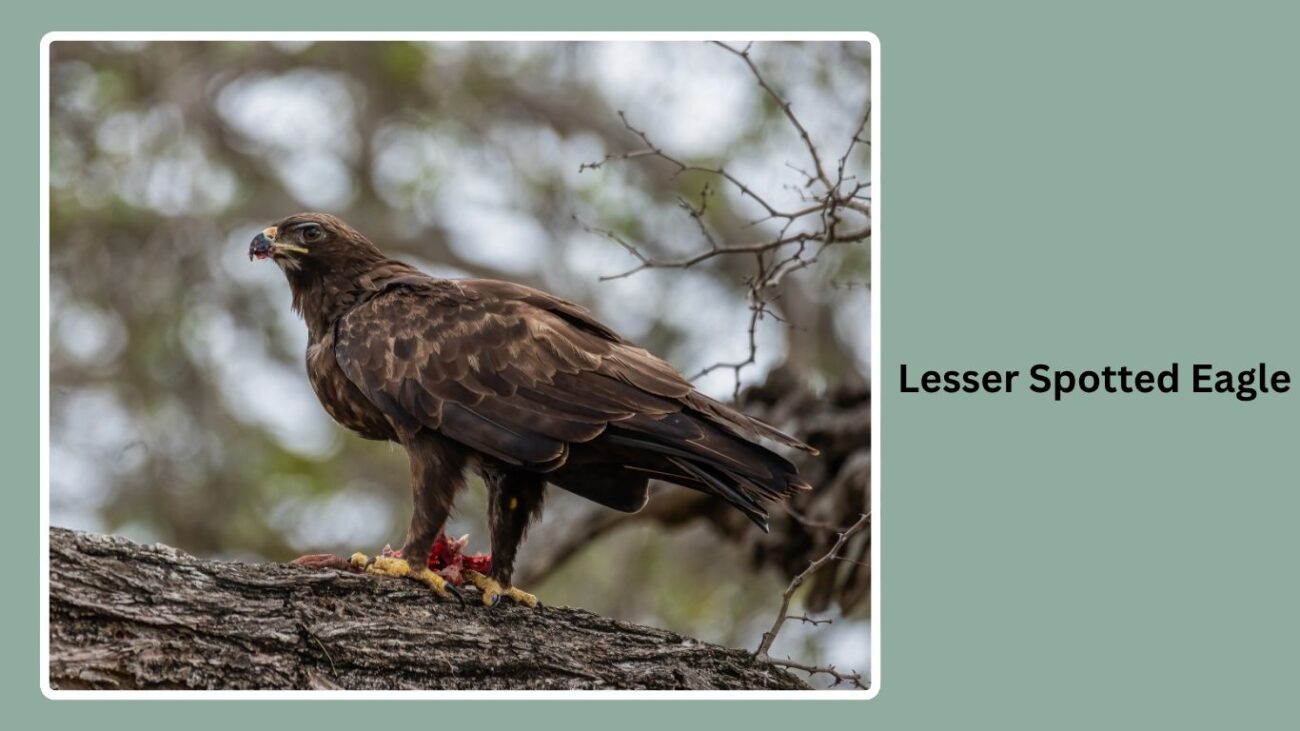
The Lesser Spotted Eagle (Clanga pomarina) is a medium-sized migratory raptor that breeds in eastern and central Europe and winters in sub-Saharan Africa. Though similar in appearance to the Greater Spotted Eagle, it is slightly smaller and more compact, with a distinct hunting style and call.
Identification
- Dark brown overall with slightly paler head and neck
- Small white spot at the base of the flight feathers (visible in flight)
- Yellow eyes and cere
- Feathered legs
- Wingspan: around 5.2 to 5.9 feet
Color Pattern
It has a generally dark brown body, with lighter mottling on the upper wings and back. In flight, a faint white patch at the base of the primary feathers and slightly paler coverts can be noted.
Habitat
Lesser Spotted Eagles prefer forest edges, meadows, marshlands, and agricultural areas. They nest in mature trees but hunt in open fields and grassy patches.
Hunting and Diet
Their diet mainly consists of small mammals like voles, frogs, insects, and reptiles. They hunt by gliding low over fields and meadows or by perching quietly before pouncing. Insects like grasshoppers and beetles make up a large part of their diet during summer.
20. Verreaux’s Eagle
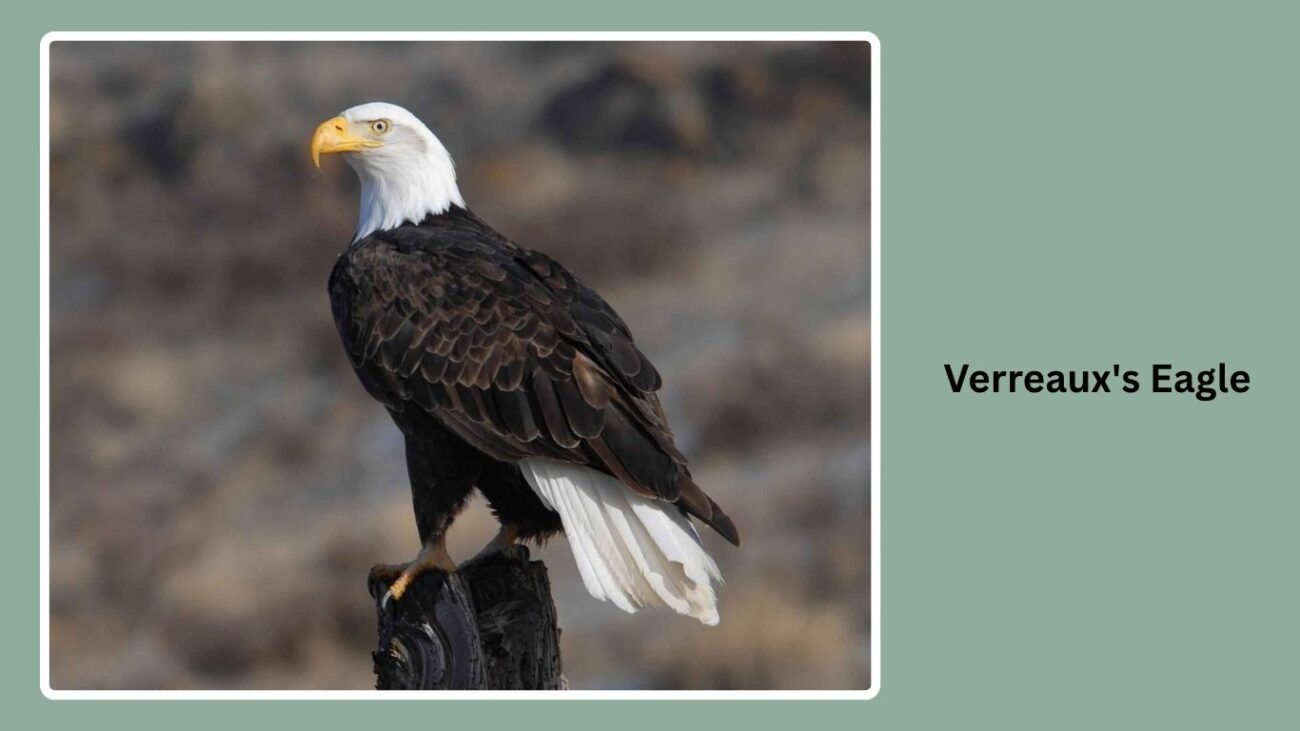
Verreaux’s Eagle (Aquila verreauxii), also known as the Black Eagle, is a striking and powerful bird native to mountainous and rocky regions of eastern and southern Africa. It is known for its deep black plumage and strong territorial behavior.
Identification
- Almost entirely black body
- White “V” pattern on the back visible in flight
- Yellow cere and feet
- Large hooked beak
- Wingspan: 7 to 8.2 feet
Color Pattern
Adults are mostly black with a distinctive white V-shape on the back, visible only when flying. Juveniles are brown with paler markings and darken as they age.
Habitat
They are found in rugged mountainous areas, cliffs, and rocky gorges. Common in eastern and southern Africa, they prefer locations with plenty of ledges for nesting and open terrain for hunting.
Hunting and Diet
Verreaux’s Eagles specialize in hunting hyraxes (rock rabbits), which make up the bulk of their diet. They also eat small mammals, birds, and reptiles. They hunt in pairs using coordinated soaring and diving tactics to ambush prey in rocky crevices or open slopes.
21. Bonelli’s Eagle
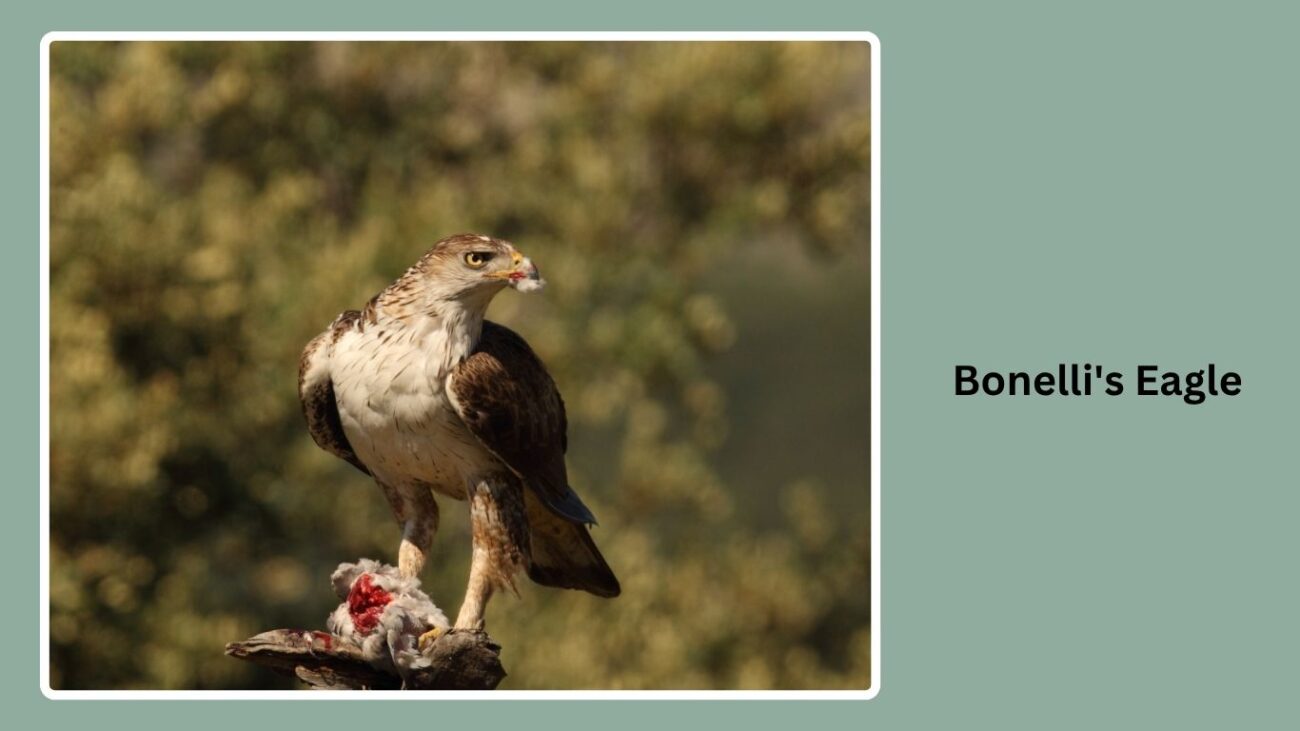
Bonelli’s Eagle (Aquila fasciata) is a medium-to-large eagle found in southern Europe, North Africa, the Middle East, and parts of Asia. It is known for its agile flight and bold hunting style, often taking on fast-moving prey in rugged terrain. Though not as large as other eagles, it is highly territorial and a skilled predator.
Identification
- Brown upperparts and pale underparts with fine streaking
- Dark eye stripe across the face
- Long, rounded wings and a moderately long tail
- White patch on the back (visible in flight)
- Wingspan: around 5.5 to 6.2 feet
Color Pattern
Adults have dark brown upperparts and light underparts with subtle streaks and a contrasting dark line through the eyes. In flight, the white “mantle” patch on the back is a key identifier.
Habitat
Bonelli’s Eagles prefer rocky hills, cliffs, and arid scrublands. They often nest on steep cliffs and hunt in open areas like dry valleys and grasslands.
Hunting and Diet
Their diet includes birds such as pigeons and partridges, as well as mammals like rabbits and squirrels. They use high-speed flight and ambush tactics, often launching attacks from elevated perches or soaring positions. Their agility allows them to pursue prey through complex terrain.
22. Tawny Eagle
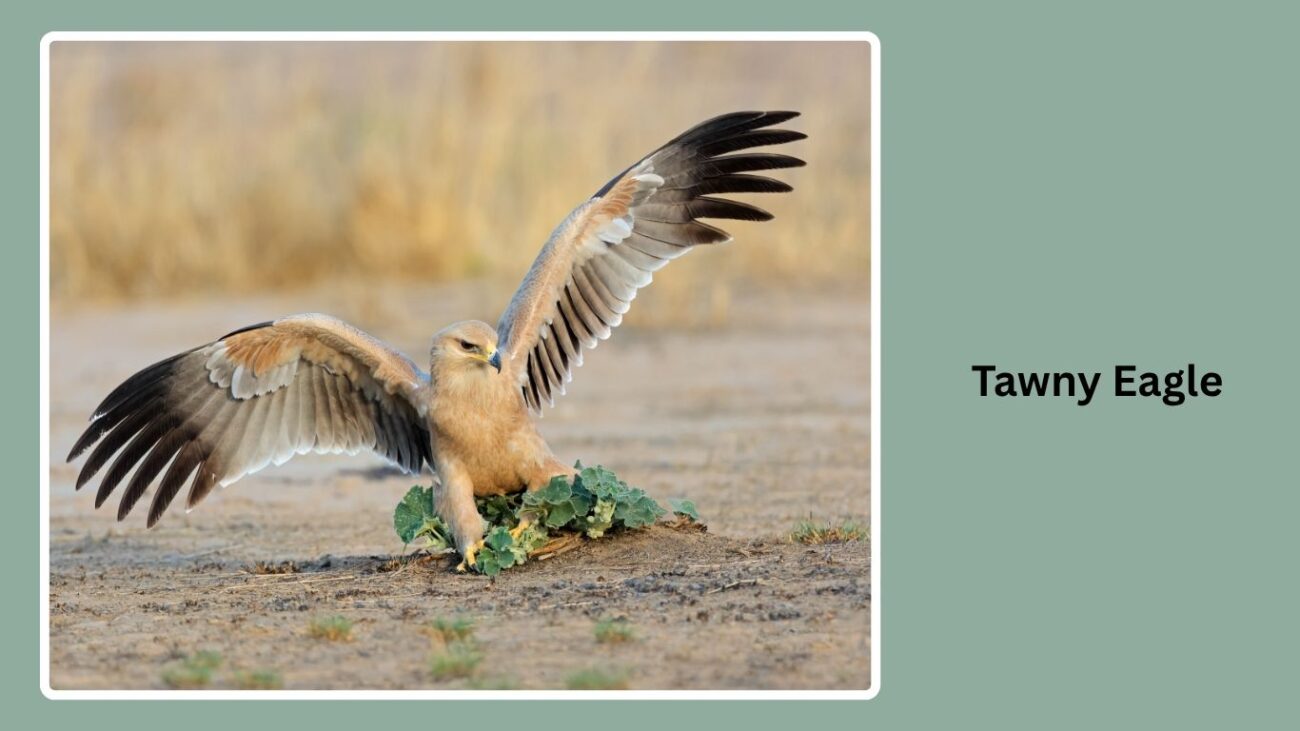
The Tawny Eagle (Aquila rapax) is a widespread eagle species in Africa and parts of South Asia, known for its adaptability and scavenging behavior. Although not as massive as some other eagles, it is a strong flier and often dominates the skies over open savannas and semi-desert regions.
Identification
- Tawny to rufous-brown plumage
- Slightly paler head and neck
- Long broad wings and a well-proportioned body
- Yellow beak base and feet
- Wingspan: about 5.5 to 6.5 feet
Color Pattern
The plumage varies from light sandy brown to dark rufous. The underwings are pale with dark flight feathers, and the tail is slightly rounded with faint barring. Younger birds tend to be paler with more streaking.
Habitat
Tawny Eagles inhabit open country—savannas, dry plains, and deserts. They are commonly seen perched on trees, power poles, or gliding low over grasslands in Africa, the Middle East, and parts of India.
Hunting and Diet
They feed on carrion, small mammals, birds, and reptiles. Tawny Eagles are opportunistic, often seen near roadkill or following vultures to carcasses. They also actively hunt, using gliding flight and sudden dives to snatch up live prey. Their versatility allows them to thrive in tough environments.
23. Pallas’s Fish Eagle
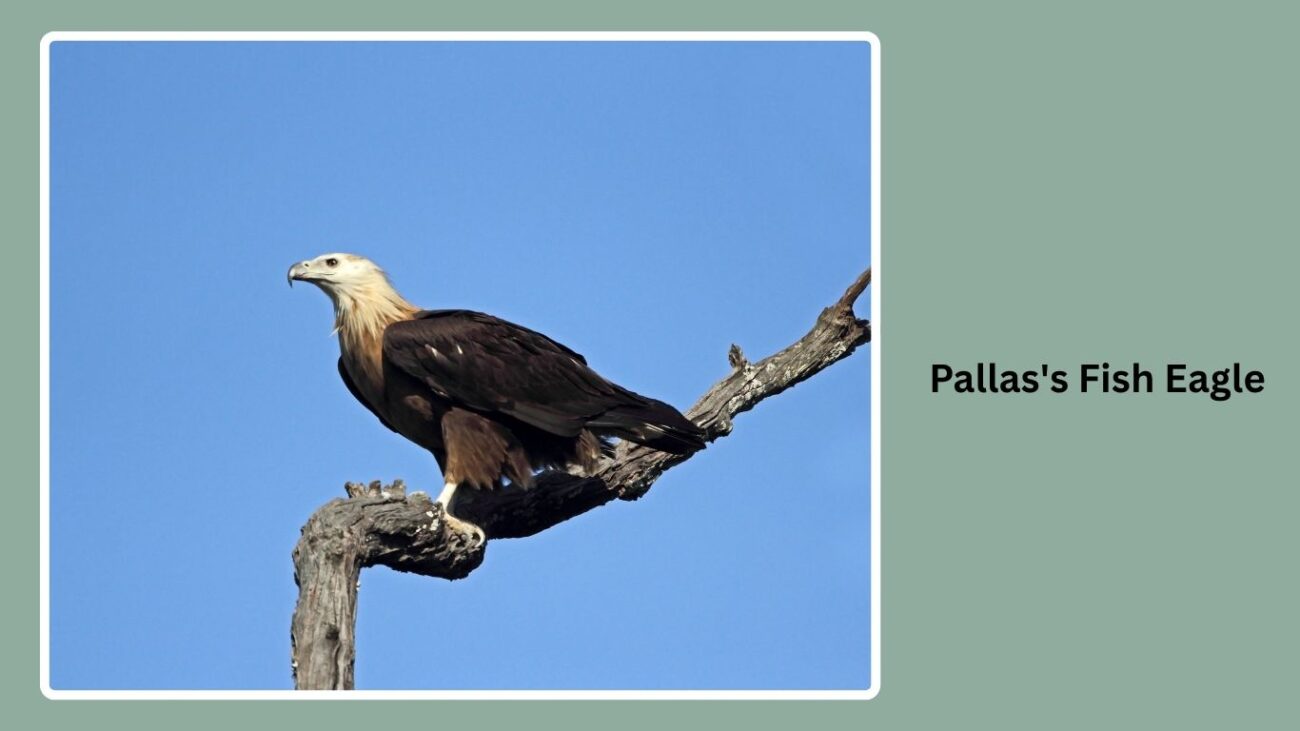
Pallas’s Fish Eagle (Haliaeetus leucoryphus) is a large and rare eagle found near lakes, rivers, and marshes in Central and South Asia. Named after the naturalist Peter Simon Pallas, it’s a fish-loving eagle that is now considered vulnerable due to habitat loss.
Identification
- Brown upperparts with pale buff head and neck
- White tail with dark terminal band
- Strong yellow beak and legs
- Large, heavy body with broad wings
- Wingspan: 6.5 to 7.5 feet
Color Pattern
Adults have chocolate-brown bodies, contrasting pale buff heads and necks, and white tails with dark tips. Their underwings show a pale panel near the body, making them easier to recognize in flight.
Habitat
They live in wetlands, rivers, lakes, and large marshes across India, Bangladesh, Pakistan, and parts of Central Asia. They need undisturbed nesting sites close to open water.
Hunting and Diet
As a fish specialist, Pallas’s Fish Eagle feeds primarily on freshwater fish, but it will also eat waterbirds, amphibians, and carrion. It hunts by swooping down from a perch or mid-air flight and grabbing prey from the water’s surface with strong talons.
24. White-bellied Sea Eagle

The White-bellied Sea Eagle (Haliaeetus leucogaster) is a striking coastal raptor found across Southeast Asia, Australia, and the Indian subcontinent. With its contrasting plumage and graceful flight, it is one of the most recognized sea eagles in the Indo-Pacific region.
Identification
- White head, breast, and belly
- Gray wings and back
- Black flight feathers and tail tips
- Strong hooked beak and yellow feet
- Wingspan: up to 6.5 feet
Color Pattern
Adults have a clean white underside and gray upperparts. The black wing tips and tail edges provide contrast in flight. Juveniles are brown with white mottling and gradually lighten as they mature.
Habitat
They are found near coastlines, rivers, estuaries, and large inland lakes. Common in India, Southeast Asia, northern Australia, and nearby islands. They nest in tall trees or cliffs close to water.
Hunting and Diet
Their diet mainly includes fish and waterbirds, but they also eat reptiles, crustaceans, and carrion. They glide low over the water and snatch prey with their talons. Known to steal food from other birds, they are both hunters and scavengers depending on food availability.
25. Grey-headed Fish Eagle
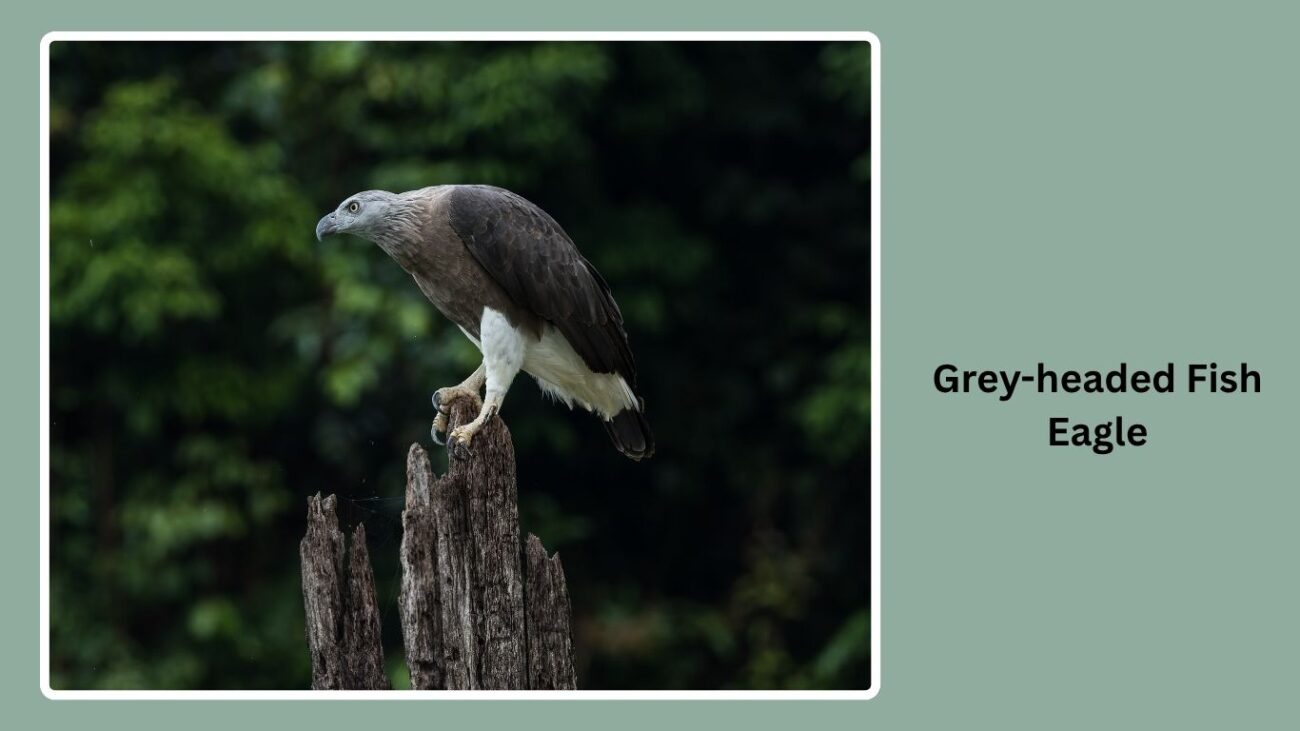
The Grey-headed Fish Eagle (Ichthyophaga ichthyaetus) is a medium-to-large raptor commonly found near rivers, lakes, and reservoirs across South and Southeast Asia. As its name suggests, it specializes in catching fish and is often seen perched quietly near water.
Identification
- Grey head and neck
- Brown upperparts and wings
- White belly and thighs
- Strong yellow feet with rough soles for gripping fish
- Wingspan: about 5.5 to 6.5 feet
Color Pattern
This eagle displays a contrasting plumage: a pale grey head and chest, rich brown back and wings, and a white underside. The tail is short with a broad black terminal band and white base, visible in flight.
Habitat
Grey-headed Fish Eagles live near freshwater habitats like rivers, lakes, flooded forests, and mangroves. They are found in countries like India, Sri Lanka, Thailand, Cambodia, Indonesia, and Malaysia, often in lowland areas.
Hunting and Diet
Fish make up the majority of their diet. They hunt by scanning from a high perch, then diving swiftly to snatch fish from shallow waters. Occasionally, they may eat amphibians, small reptiles, or carrion. Their hunting behavior is quiet and patient, typically performed alone or in breeding pairs.
FAQs
What is the largest eagle in the world?
The Steller’s Sea Eagle is considered the heaviest eagle in the world, weighing up to 9 kg (20 lbs), while the Philippine Eagle is among the tallest and has the longest body length.
Which eagle has the strongest grip?
The Harpy Eagle has the strongest grip force among all eagles. Its talons are as large as a grizzly bear’s claws, capable of crushing the bones of monkeys and sloths.
Are all eagles carnivorous?
Yes, all eagle species are carnivores. Their diets include fish, mammals, birds, reptiles, and carrion, depending on the species and environment.
How long do eagles live?
Eagles typically live 20 to 30 years in the wild. In captivity, where they’re protected from dangers, some species can live over 40 years.
Do eagles mate for life?
Many eagle species, such as the Bald Eagle, are known to mate for life. They usually return to the same nest each year, reinforcing their bond and expanding the nest annually.









